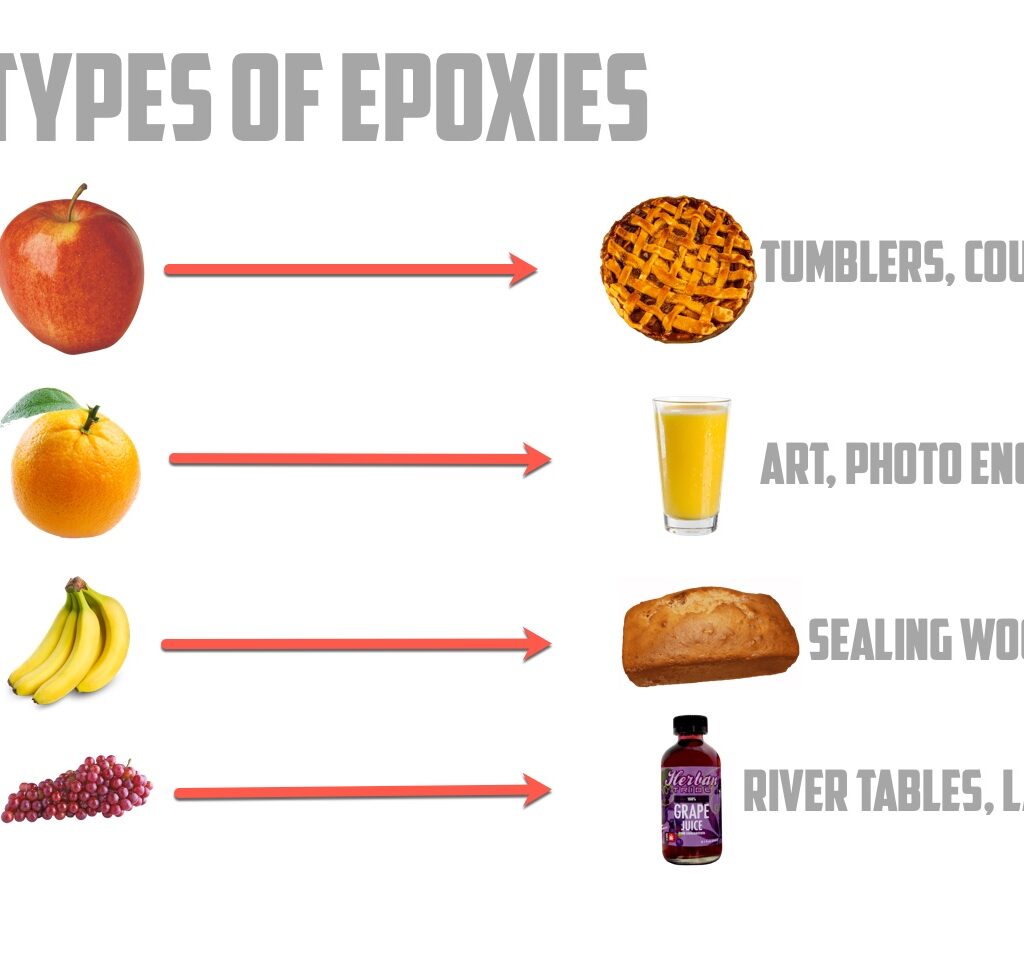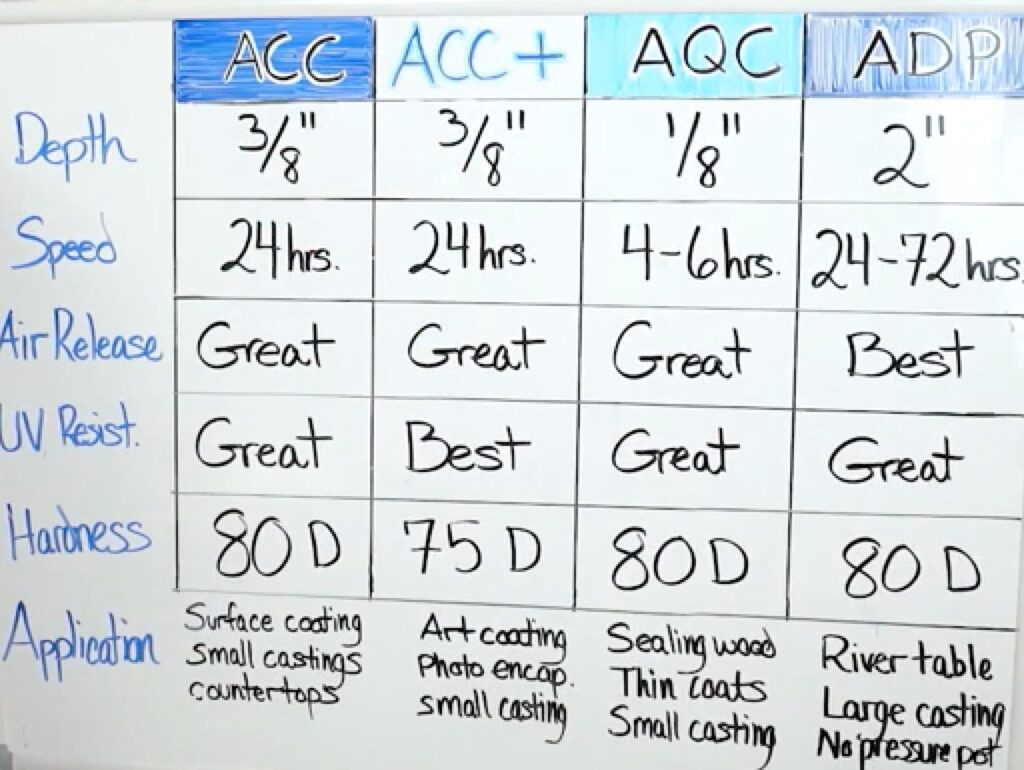Tabletop surface coating, tank coating, quick coating, winter coating, coat of arms…. I mean, it just feels like there are thousands of epoxies out there. How do you choose which one you go with? Which one do you choose for which project? That’s a lot to consider.
Here’s the secret.
All the epoxies that you see out there. Well, 95 percent of them boil down to just four different types. Let me clear the air and explain each one.
In order to explain this best, let’s talk fruit!

I’ve made a little graph quickly for me to better explain everything…we’ve got an apple, an orange, a banana and a bunch of grapes. Each one of these is going to represent a type of epoxy.
Also on the other side, you’re going to see a pie, a beautiful glass of orange juice, some bread and, well, a grape juice. Now, keep in mind, all of these are fruits, but they’re all very, very different and have different applications. An apple is delicious in pies and orange. Well, that’s a good way to start the morning. Bananas makes my all time favorite bread, banana bread. If you’d like to send me some banana bread, I’m not going to be mad at you.
And grapes. Well, grapes make grape juice. Yes, these are all fruits, but not each one of these works for all the other applications that we have over here. For instance, I don’t want anything to do with banana pie and I don’t want to deal with grape bread either. They would just get hot and it would be like a nasty Ushery fruity situation. That sounds terrible.
All right. So each one of these fruits, well, it coordinates to a certain type of epoxy.
If we look at our apples and we can call that our surface coating , you might have heard of this as a tabletop. I’ll represent that with T tabletop or orange. Let’s call that are more UV resistant. That’s going to have that extra juice in there to make sure it doesn’t yellow nearly as quickly as our bananas. We can call that our quick hearing. And then lastly, we have our grapes on here. Let’s call that our deep pores, these four types of epoxy.
That’s it. I mean, that’s 99 percent of the epoxy that you see out there on Amazon online and all these YouTube videos. They’re one of these four types. So what are these four types of poxes good for and what are they not good for? Well, for surface coatings and tabletop a poxes tumblers counters. That stuff is perfect for it’s made for that for UV resistant stuff. That’s where art comes into play. Photo encapsulation stuff you want to protect and have it not yellow.
So quickly now quick curing epoxies are perfect for sealing wood for fast coatings, when you need to keep going on a project and you don’t want to wait twenty four hours for something to cure. And then deposit boxes are obviously perfect for river tables, large castings, and you still want beautiful clarity. Now these four types of epoxy are great, but this isn’t enough information. I don’t think. I think you need more details. I’m not going to be able to talk through all the other competitive products out there because, well, I don’t have all those details, but I do have details.

So let’s use our products as the examples. take a look at this board i have written on and I’ll talk through these products. All right. Here’s our chart. Here are our four epoxies. Clear cast. That’s our surface coating or tabletop amazing clear cast. Plus, that’s our UV resistant one amazing quick coat. That’s our fast curing.
And then amazing D for you guessed it hard for possie on this side. I’ve got some attributes that we should talk about. Depth, speed, air release, UV resistance, hardness and then applications again, because that’s really why you’re here. All right. So for depth’s, for amazing clear cast, an amazing clearcuts. Plus, you’re looking at about three eights of an inch, not quite half of an inch for amazing quick coat. It’s an eighth of an inch.
Remember, that’s a fast setting epoxy. So we’re dealing with more exothermic there. Camper’s deep and for making deeper. Well, that’s two inches. That is ideal. All right. Let’s talk speed through you off didn’t on that. I definitely do. You got you. All right. Let’s talk speed for amazing clear cast, an amazing clear cast. Plus, you’re looking about about a twenty four hour tax free time. Depends on your temperature. So always keep that noted.
Allow four to six hours. That’s fast. Hence quick coat, although your pour can take time. Twenty four to seventy two to get that tax free. Depends on your temperature again. Is this fully cured. No, that’s still five to seven days or three to five days depending on your product. Next up, air release. Here’s the thing. I’m going to shoot you straight. We formulate all of these to have amazing air release for their applications.
I’ve put the best over here for amazing deep for so that you realize a two inch pour is going to take a lot of air release in order to get that crystal clear. That’s why medicore is water thin so that the bubbles can get out of there. But keep in mind, it’s water thin. It’s not going to do a good job coating a tumbler. Go ahead, pour water on your tumbler and let me know how much of it stays on UV resistance.
I think you can predict this one. The best on this board is definitely the UV resistant epoxy. Wonder why. I will say, though, we do formulate every one of our poxes, though, to have fantastic UV resistance as much as possible within that formulation. No, but if you’re looking for that extra juice, you want to ask plus second to last. Let’s talk about hardness. That’s sure. Hardness on the D scale.
What is that?
It’s a lot of acronyms are 80 on the short scale. That means that they’re really hard and really durable, but not that far behind is amazing clearcuts. Plus with seventy five dollars, these things are as hard as like construction work or hard hats. There’s nothing soft here, folks.

Why should you care about hardness? Well, the fact that we’ve made these really, really strong just means that it’s going to be a lot more durable. It’s got to be harder to dig up your projects and scuffling. Last but not least, Lippestad assistance is the application. When should you use this stuff? Right. So for a surface coating epoxy like Almazan Clear cast, this is for, believe it or not, surface coating, small castings, countertops, stuff where you’re going to pour on a flat surface or around a surface that you’re going to rotate consistently and get a beautiful thane coating for amazing clearcuts.
Plus, we’re looking at art coatings, photo encapsulation, something where you want that project to last as long as possible because it has maybe sentimental value memories to it or it’s going to be outside a lot like a Tumblr where that you’re taking around here. That’s great. If you need that extra UV resistance for Amazing Quico, this is where we’re sealing wood for me. I use this to seal up a board before I pour a deeper foxe on it.
That means that I’m not going to have any air bubble issues or moisture issues. And since it’s only going to take four to six hours, I can keep my project moving for amazing deeper. Well, I hope it’s obvious by now, but River Table’s large castings things where you’re really pouring thick and you need that extra time for the air to release and you need the extra time to make sure it doesn’t exothermic turn yellow and cross. So there it is.
Now, you know, the four different types of epoxy when to use each one and kind of what are the features and benefits of each. If you want to see more content like this, if you’ve got specific questions, I want to know about them. Put them in the comments below and answer them.

